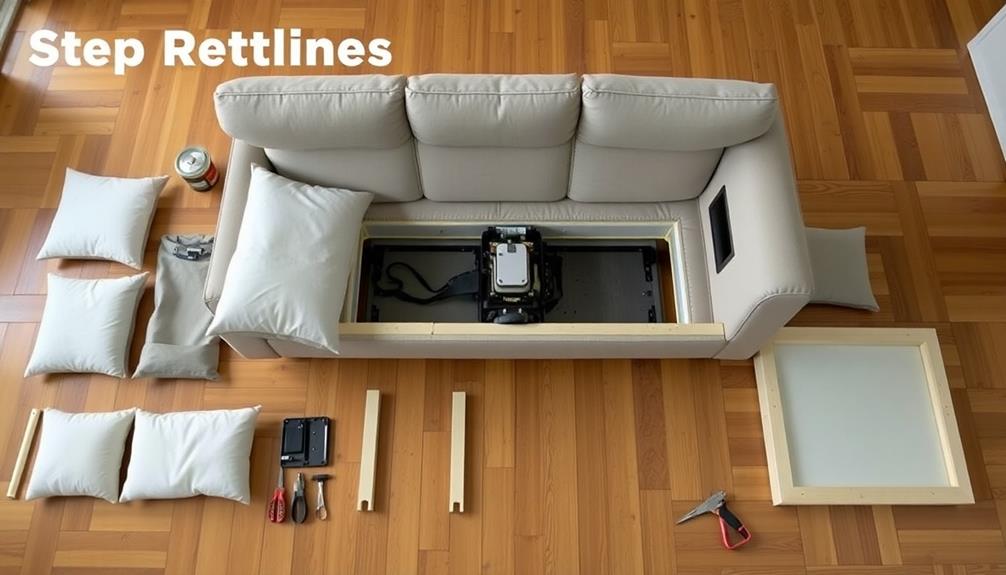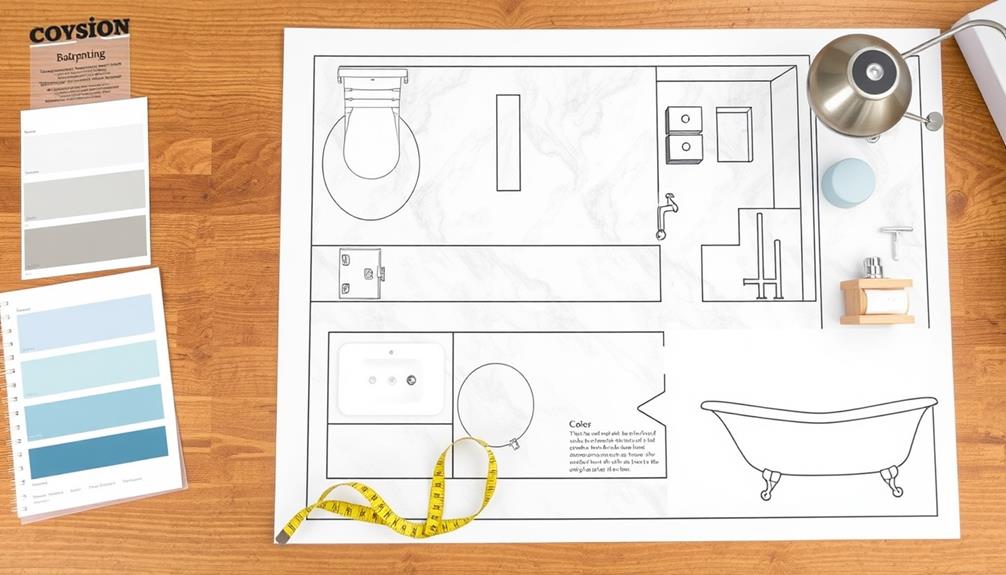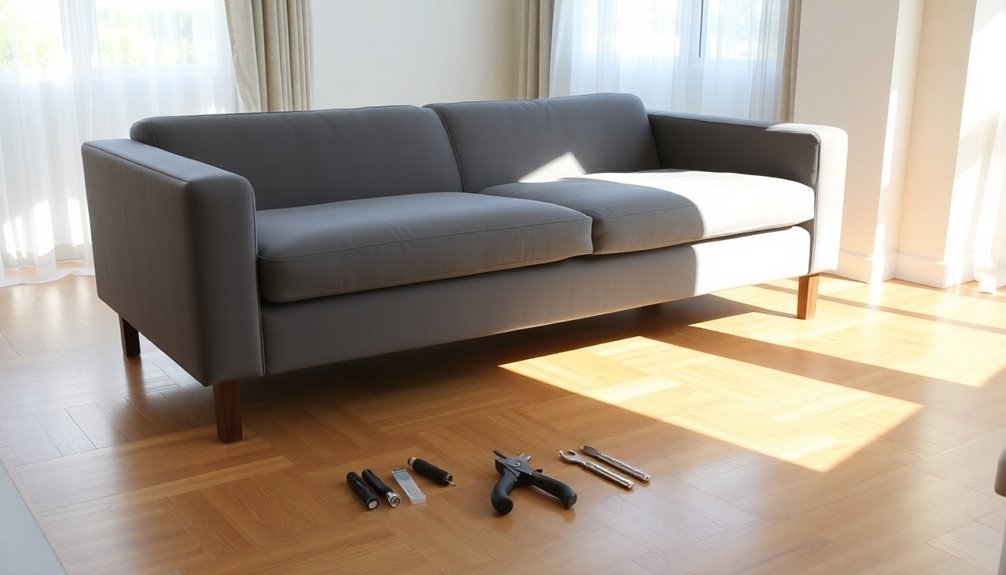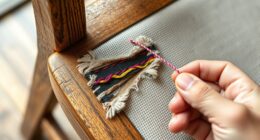In order to disassemble a reclining sofa for moving, you should begin by clearing the area and gathering necessary tools such as a screwdriver, wrench, and gloves. Start by removing the backrest, which is usually secured with Velcro or screws. Carefully unplug any electrical components and then lift off the cushions. Unscrew the reclining mechanism, making sure to support it as you work. Locate and remove the screws holding the armrests in place, being careful to keep track of any parts that may come loose. Keep all hardware organized in a labeled bag for easy reassembly later. You can find more helpful tips to make this process even easier.
Key Takeaways
- Gather essential tools such as a screwdriver, wrench, and pliers for disassembly and ensure you have gloves for safety.
- Remove the backrest by checking for screws or Velcro and unplug any electrical components carefully.
- Detach seat cushions and unscrew the reclining mechanism, taking care to support it while working.
- Unscrew armrests by locating screws, maintaining organization of hardware in a labeled bag for reassembly.
- Use proper lifting techniques and moving equipment to safely transport the disassembled sofa through doorways and stairs.
Tools Needed for Disassembly
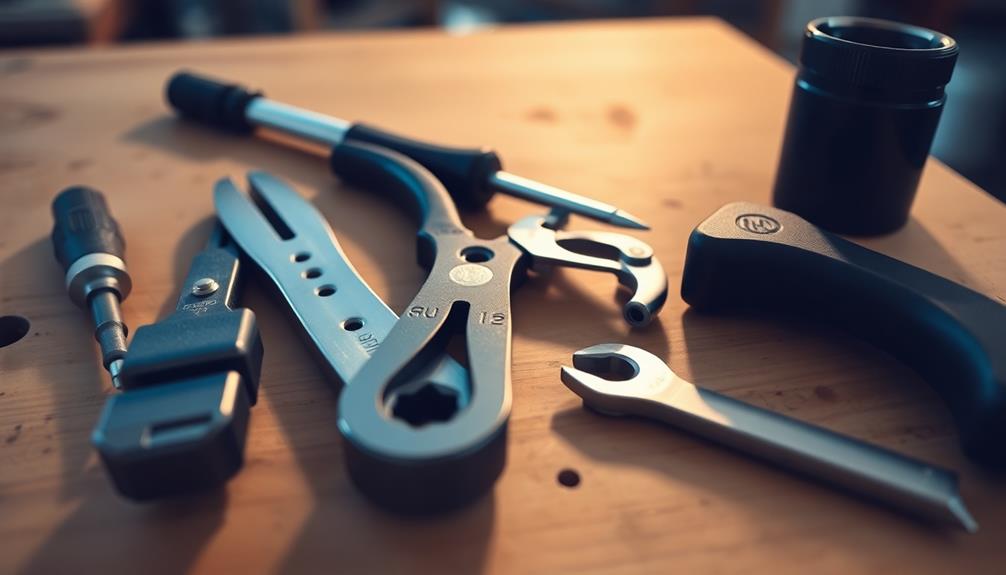
Before you plunge into disassembling your reclining sofa, it's vital to gather the right tools for the job. Having the right tools ready won't only help you move the couch more efficiently but also make it easier to tackle various fasteners and screws.
Start by grabbing a screwdriver, a wrench, and pliers, as these are the primary tools needed for removing screws and bolts securely. Additionally, understanding your budgeting techniques can help you plan for any unexpected moving expenses that may arise.
Next, don't forget a measuring tape. Measuring the recliner's dimensions before disassembly is critical to guarantee it fits through doorways and hallways without any hassle.
If there are any electrical wires or components secured with zip ties, a utility knife will come in handy to cut those safely.
Protect your hands with gloves to avoid injuries from sharp edges or hidden fasteners.
Finally, keep a labeled bag nearby to store all screws, bolts, and small components you remove. This little step will make reassembly easier once you reach your new location.
With the right tools and precautions in place, you'll be well on your way to successfully disassembling your reclining sofa.
Preparing the Sofa for Moving
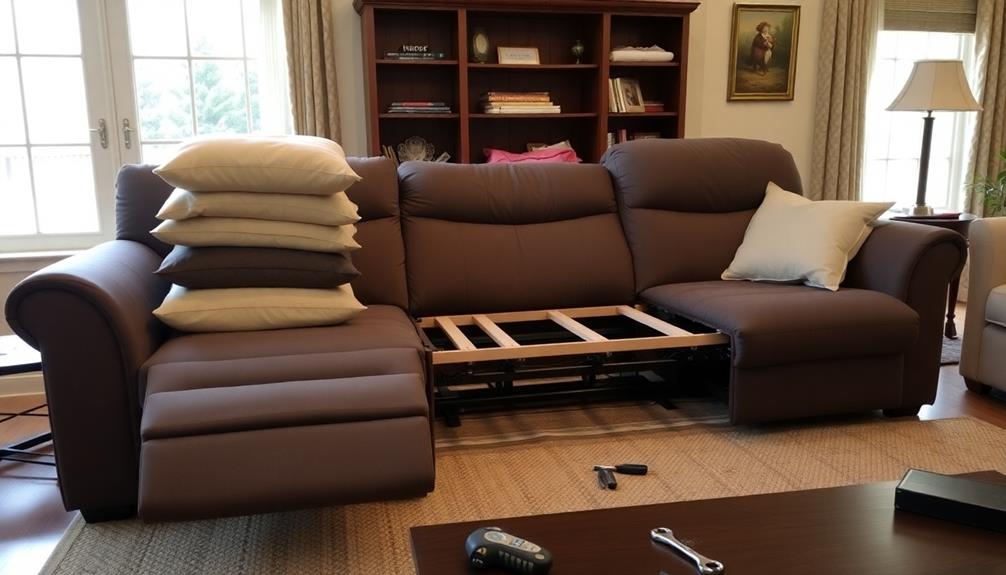
To prepare your reclining sofa for moving, start by removing the backrest, which is typically secured with Velcro or screws. Be ready for some dust and debris to fall out during this process, so it may be beneficial to have a vacuum handy for dust removal efficiency.
Before you begin disassembly, unplug any electrical wires from the recliner, being careful with any clips that might need gentle handling.
Next, clear the surrounding area of obstacles to make the process smoother. Measure the dimensions of your sofa to guarantee it'll fit through doorways and hallways when moving. This step is vital to avoid any last-minute surprises.
Gather the necessary tools, such as a screwdriver and wrench, and check for hidden fasteners or screws that might need removal for complete disassembly. Wearing gloves is a smart move for safety while handling components.
As you remove parts, keep all hardware in a labeled bag. This little organization step will make reassembly a breeze once you've moved.
Taking these precautions will help guarantee your reclining sofa is ready for a smooth changeover to its new home.
Removing the Sofa Back
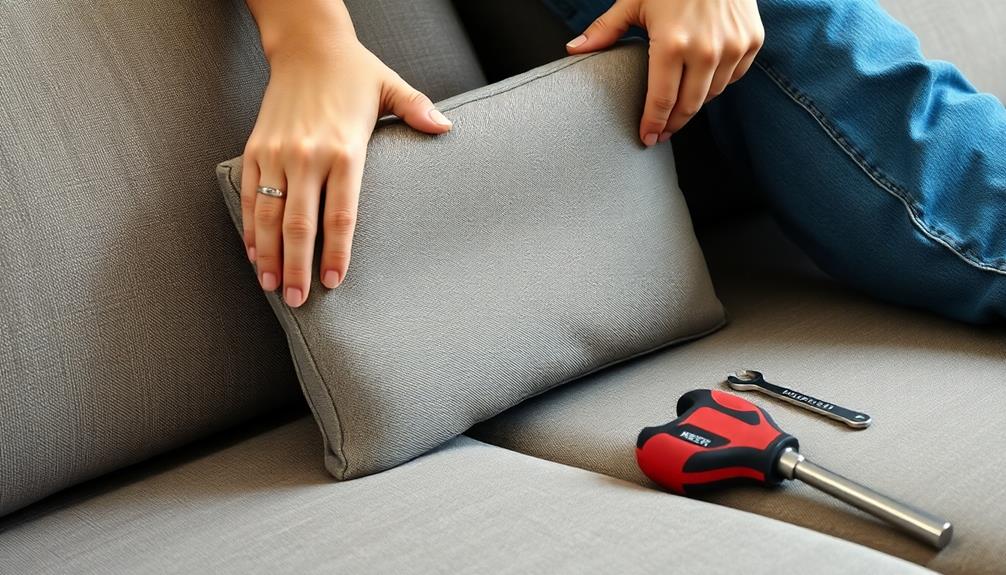
When you're ready to remove the back of your reclining sofa, start by checking for any fasteners like Velcro or screws that may be securing it. Make certain to inspect all sides and corners, as these can often be overlooked.
If your sofa has electrical components, unplug the wires before you proceed to avoid damaging any connections. It's also a good idea to take into account the energy-efficient appliances in your home to guarantee you're minimizing energy consumption during the move.
Prepare for some dust and debris to fall out when removing the sofa back, so it's wise to have a drop cloth or vacuum nearby. Wearing gloves is a good idea, as some clips holding the back might be stiff from infrequent disassembly. This extra layer of safety can help you avoid any injuries during the process.
Once you detach the back, keep all hardware—like screws and clips—in a labeled bag. This will make reassembly much easier when you move your sofa into its new space.
As you work, be cautious of any pieces of wood that may be part of the frame, and handle them gently to prevent damage. By following these steps, you'll successfully manage removing the sofa back with ease.
Detaching Cushions and Mechanisms
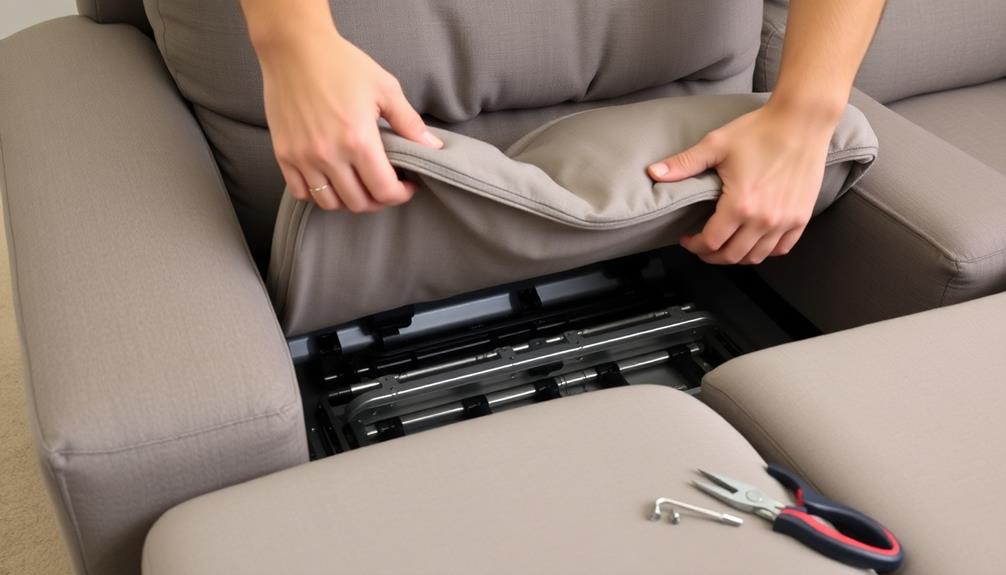
To start detaching the cushions and mechanisms, lift off the seat cushions since they're usually not attached. This step is essential as it allows for better access to the reclining mechanism, which may be secured with bolts.
Once the cushions are out of the way, locate and unscrew any bolts securing the reclining mechanism to the frame. Be sure to support the mechanism as you detach it to avoid any accidents.
Additionally, ensuring a well-draining soil for plants nearby can help maintain a fresh environment during your moving process.
Removing Seat Cushions
Start by lifting the seat cushions straight up to release them from their slots, as most cushions are designed to be detachable. This simple step is essential for removing seat cushions effectively.
Before you fully remove them, check for any securing mechanisms that may be holding the cushions in place. Additionally, consider the importance of maintaining a clean and organized moving environment to prevent any damage to the sofa or its components.
Common types of cold medications can also be helpful if you're dealing with any discomfort during the moving process.
Here's a quick guide to help you:
- Inspect for Velcro or Clips: Look underneath the cushions for any Velcro strips or clips. If you find them, unfasten these attachments to free the cushions completely.
- Lift with Care: Once unfastened, gently lift each cushion straight up, ensuring you don't snag any fabric or hardware.
- Store Removed Cushions: Place all removed cushions in a designated area to keep them organized and safe during the move.
- Check for Damage: As you're removing seat cushions, examine the cushions for any wear and tear, which might need attention before reassembly.
Completing these steps will make it easier to transport your sofa without any hitches.
Detaching Reclining Mechanism
After removing the seat cushions, you'll have clearer access to the reclining mechanism of your sofa. Start by identifying any visible bolts or screws that secure the reclining mechanism to the sofa frame. These are usually located where the mechanism meets the seat. Use a screwdriver to carefully unscrew them.
| Step | Action | Notes |
|---|---|---|
| 1 | Remove cushions | Look for Velcro or zippers |
| 2 | Identify screws | Check the junction points |
| 3 | Unscrew the bolts | Keep screws in a bag |
| 4 | Detach the mechanism | Support it while removing |
Once you've removed the screws, carefully detach the reclining mechanism from the sofa. Be certain to support it to prevent any strain or damage. If your sofa has electrical components, disconnect any wires or clips attached to the reclining mechanism before fully removing it. Remember to keep all removed hardware in a labeled bag for easy reassembly after you relocate your sofa. Following these steps guarantees a smooth detaching process for your reclining mechanism.
Unscrewing Armrests and Bolts
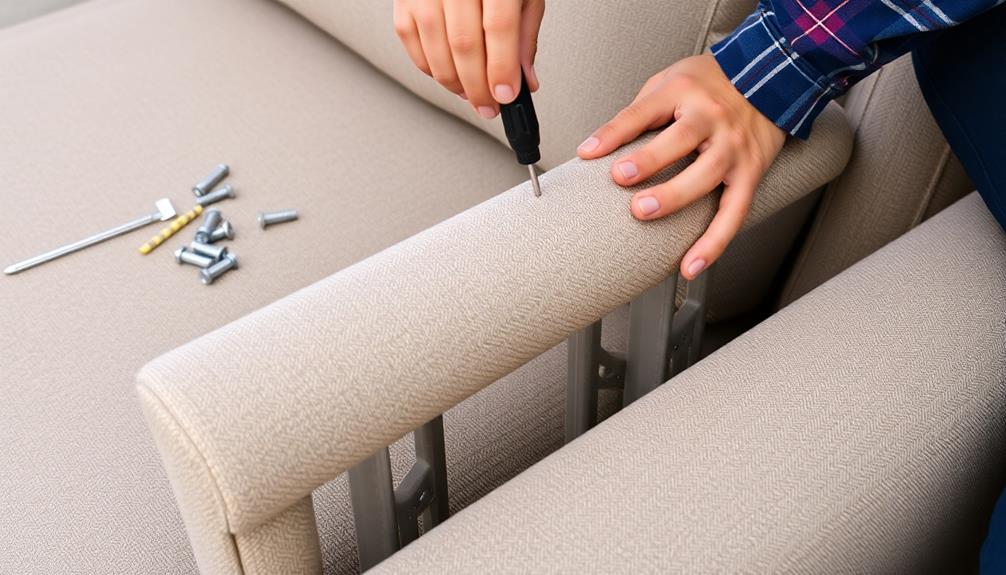
When you're ready to detach the armrests from your reclining sofa, begin by removing any cushions or coverings that might be hiding the screws or bolts securing them to the frame.
It's important to handle the disassembly carefully to maintain the integrity of the sofa and to prevent any damage during the process. Start with these steps: Remove any cushions and pillows first to give yourself better access to the frame and screws. Then, begin by unscrewing and detaching any removable parts like the legs, armrests, or backrests to make the process easier. This method is especially useful when you need to dismantle couch for narrow doors, ensuring that it can pass through tight spaces without causing damage.
- Locate the screws or bolts: Check for visible hardware securing the armrests. If you can't find them, look for hidden screws behind fabric flaps or Velcro. You might also want to take into account the benefits of using non-toxic cleaning solutions for the upholstery while you're at it, especially if it's been a while since the last clean non-toxic cleaning solutions.
- Use the right tools: Grab a screwdriver or wrench to unscrew the visible bolts or screws. Make sure to keep all hardware in a labeled bag for easy reassembly later.
- Wiggle the armrests: Gently wiggle the armrests to release any clips or fasteners that could be holding them in place. This step is essential to avoid unnecessary force, which might damage the sofa.
- Lift straight up: Once the screws are removed, verify you lift the armrests straight up and away from the sofa to prevent damaging any surrounding components.
Navigating Doorways and Stairs
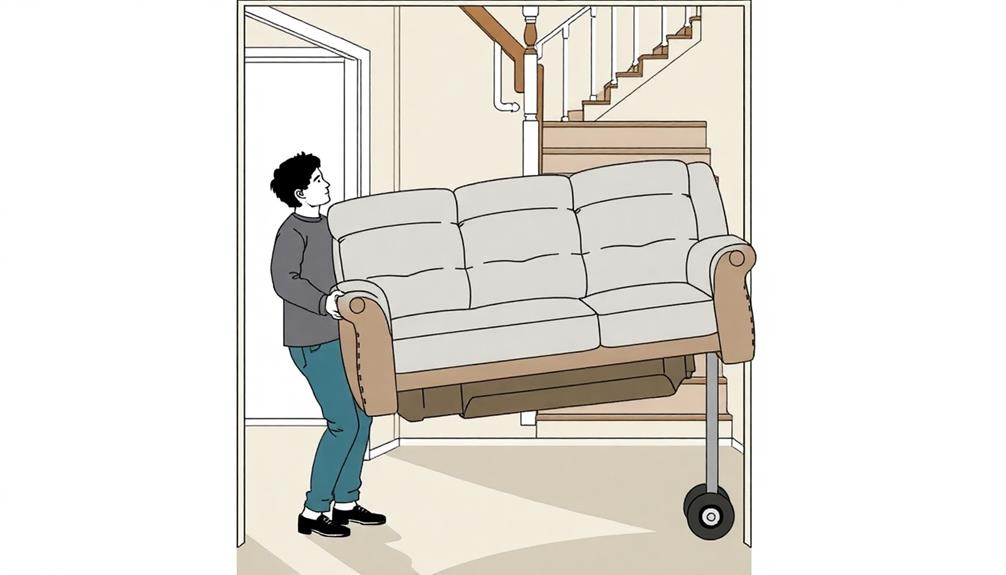
Maneuvering doorways and stairs with a reclining sofa can be a tricky task, but with the right strategies, you can make the process smoother. When you approach a door frame, angle the sofa low to avoid hitting the top. Lean the sofa back to reduce its height and increase your clearance.
If you encounter tight spaces, use a right triangle approach by angling the sofa diagonally; this helps navigate through while minimizing the risk of damage. Additionally, consider the value of home security systems as a precaution while moving, especially in unfamiliar areas where you might be distracted. The presence of security systems can deter potential burglars, making your moving experience safer and more secure increased safety and peace of mind.
As you move onto stairs, a hand truck will be invaluable. Securely fasten the sofa to the dolly to maintain control and prevent shifting. Be cautious of any arm slants or protruding parts that could hinder your positioning.
When descending stairs, use the dolly to manage shock waves, ensuring a smooth passage without damaging the furniture or surrounding areas.
Using Moving Equipment Effectively
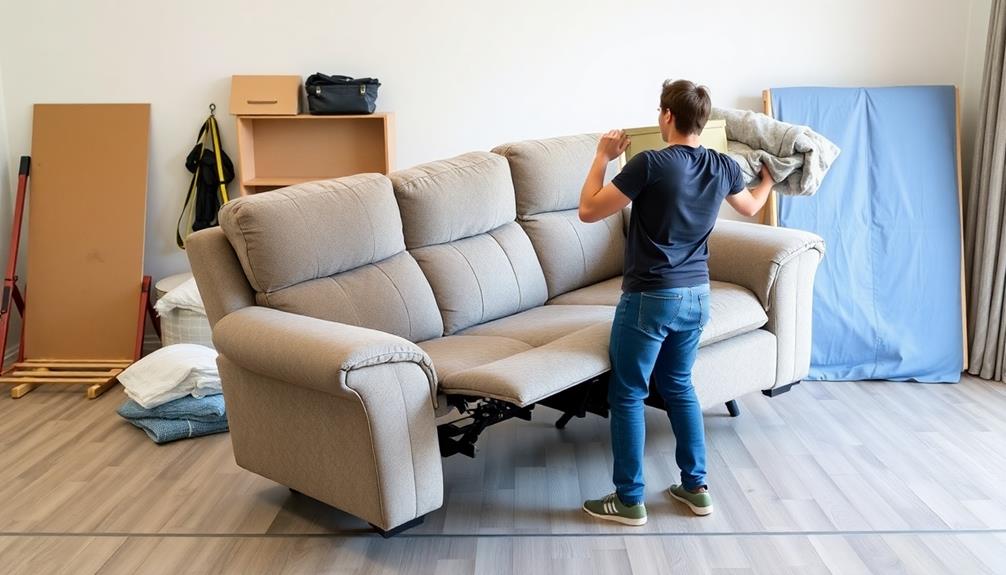
Using the right moving equipment can make all the difference in safely transporting a reclining sofa.
You'll want to guarantee you've got the proper tools to maintain control and prevent damage. For preppers, understanding the importance of essential survival tools can translate into effective moving strategies as well.
Here are four essential items to evaluate:
- Four-Wheel Dolly: This provides ideal balance and stability. Position the couch on its side to minimize surface area, reducing the risk of damage.
- Hand Truck: When using a hand truck, secure the couch properly to prevent tipping. Approach doorways at a low angle to maneuver tight spaces without hitting the top.
- Moving Straps: These help distribute weight evenly, allowing you to lift and maneuver the couch with ease, especially when traversing stairs or tight corners.
- Good-Condition Wheels: Check that the wheels of your moving equipment are in good condition and suited for the sofa's weight. This enhances control and minimizes accidents during transport.
Don't forget to leverage your foot to adjust the positioning of the moving tool while handling the couch.
This provides better control and stability throughout the moving process.
Safe Handling Techniques
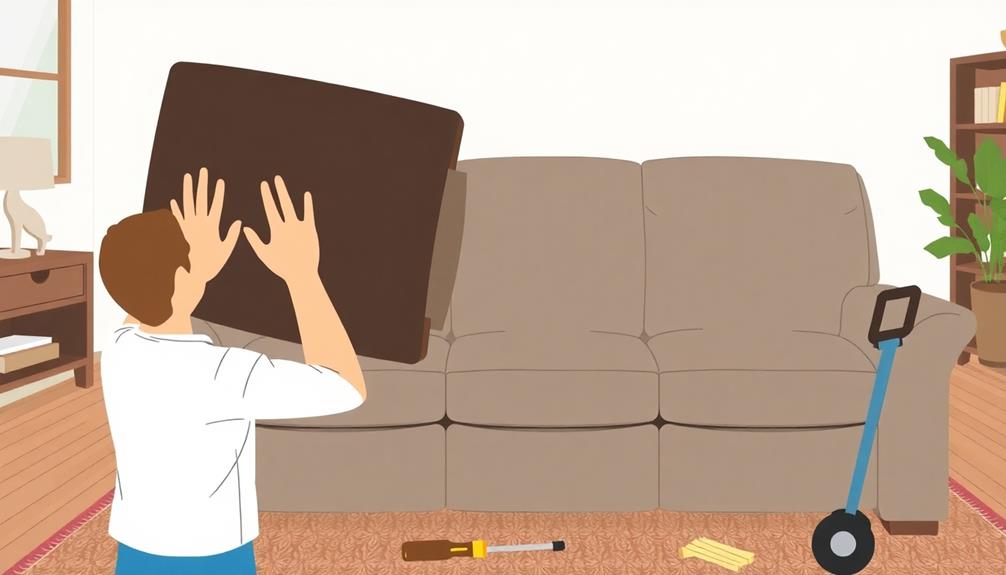
When handling a reclining sofa, it's essential to use proper grip techniques to maintain control and prevent accidents.
Additionally, ensuring a clean environment can help prevent dust and allergens from causing issues during the moving process, similar to regular air purifier maintenance.
Balance the weight evenly to avoid strain on your body, especially when maneuvering tight spaces.
Proper Grip Techniques
Proper grip techniques are essential for safely handling a reclining sofa. A secure grip not only helps you maintain balance but also prevents accidents during transport. Here are some key methods to guarantee you handle the sofa effectively:
- Firm Grip: Always keep a firm grip on sturdy parts like the frame or armrests. This prevents slipping and gives you better control, similar to how a firm hold is important when maneuvering New England's diverse tent camping locations.
- Two-Handed Lift: Use both hands to distribute weight evenly. This minimizes strain on your back and enhances your ability to balance the sofa.
- Knees and Back: When lifting or adjusting, bend at your knees and keep your back straight. This way, you engage your legs' strength while maintaining a secure grip.
- Dolly Positioning: If you're using a dolly, position the sofa with the back facing it. This maximizes support and stability, making transport easier.
Weight Distribution Strategies
Effective weight distribution is essential for safely handling a reclining sofa. Start by distributing the weight evenly across your moving tools, like dollies or hand trucks, to maintain balance and prevent tipping during transport. When you lift the sofa, keep the heaviest side closest to your body. This technique reduces strain and enhances stability.
Using a team approach can considerably help with weight management. Have two or more people share the load, which allows for better control as you maneuver the sofa. It's vital to adjust the angle of the couch during transport to lower its center of gravity—this tactic stabilizes the load and decreases the risk of accidents.
Additionally, secure the couch with straps or ropes to the dolly or hand truck. This precaution prevents the weight from shifting during movement, ensuring safer handling.
Navigating Tight Spaces
Maneuvering tight spaces can be tricky, but with the right techniques, you can maneuver a reclining sofa with ease. The key is preparation and understanding how to safely navigate your environment. Here are some steps to follow:
- Assess the Space: Before you move, check the dimensions of doorways and ceilings. You need to be able to visualize how the couch will fit through these areas.
- Approach at a Low Angle: When you're ready to move, approach doorways at a low angle. Tilt the couch back to reduce its height for a smoother passage.
- Use a Right Triangle Technique: Angle the couch diagonally to optimize clearance. This method helps you navigate narrow areas more effectively.
- Maintain a Firm Grip: Always keep a strong hold on both the couch and dolly. This is essential for preventing accidents during transport, especially in confined spaces.
The next step is to stand the couch upright when necessary, ensuring you're maneuvering with control.
Cleanup After Disassembly
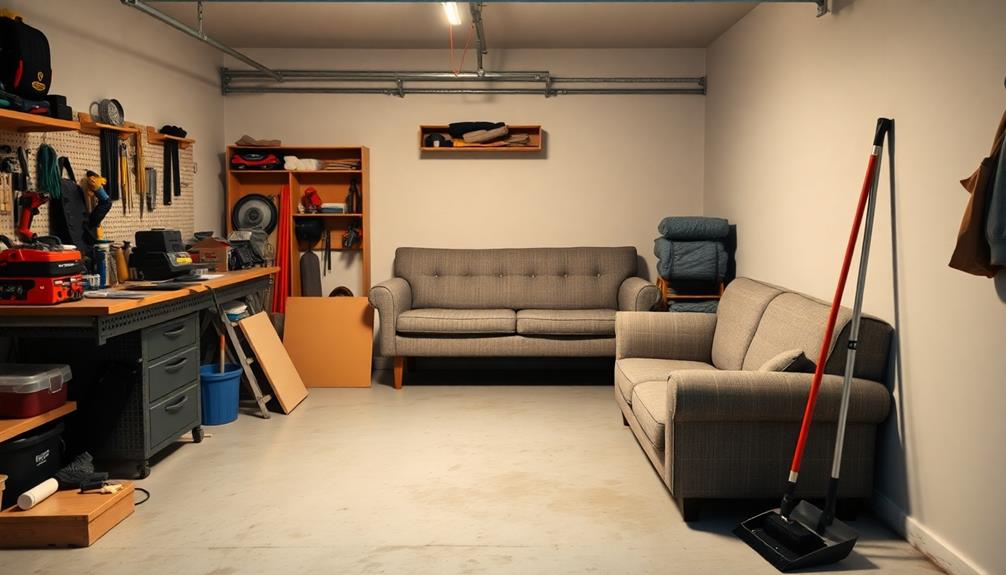
Once you've taken apart your reclining sofa, the cleanup process is crucial for maintaining a tidy space. Start by removing the cushions and placing them in a designated area. Make certain to keep all hardware in a labeled bag for easy reassembly later. This way, you won't have to dig through piles of screws and bolts when it's time to put everything back together.
Next, sweep or vacuum the area where the recliner was located. This step helps clear away any dust, debris, or small parts that may have fallen during disassembly.
Don't forget to check the front of the couch area as well, as loose items can often end up there.
While you're cleaning, inspect the floors and walls for any damage that might've occurred during the removal process. If you notice any issues, address them promptly to avoid further complications.
Disposal and Donation Options
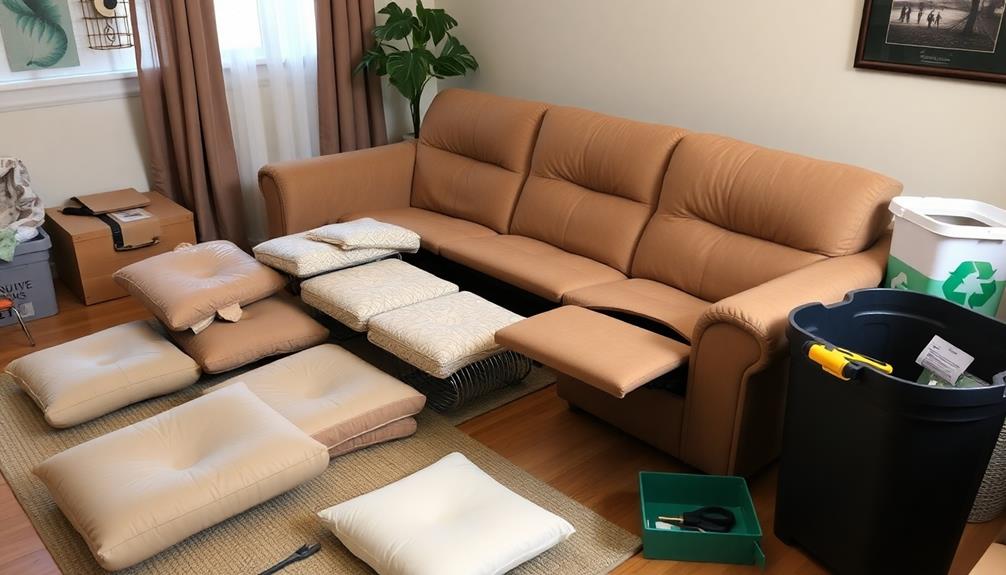
After you've cleaned up the area, it's time to reflect on what to do with your reclining sofa. You've got several options to take into account, depending on its condition.
- Check Local Regulations: First, look into your local regulations regarding bulky item disposal. Compliance with waste management policies is essential to avoid fines.
- Donate: If your sofa is still in good shape, think about donating it to local charities, shelters, or thrift stores. Many organizations will even arrange for pickup to make it easier for you.
- Recycling: Research nearby recycling centers that accept upholstered furniture. These facilities can often repurpose materials like wood, foam, and metal, reducing waste.
- Junk Removal Service: If the sofa is beyond repair, hire a junk removal service that specializes in furniture disposal. This guarantees that your sofa is disposed of responsibly and in an environmentally friendly manner.
No matter what you choose, be sure to clean the area thoroughly afterward, disposing of any debris and checking for potential damage to the surrounding space.
Frequently Asked Questions
Do Reclining Sofas Come Apart for Moving?
Yes, reclining sofas often come apart for moving. You'll find removable backs, cushions, and sometimes detachable mechanisms. Just make sure to check for screws or fasteners, and keep everything organized for easier reassembly later.
How to Take Apart a 3 Seater Recliner Sofa?
To take apart a 3 seater recliner sofa, start by removing the cushions and back. Unscrew any visible bolts, detach the reclining mechanism, and carefully label all hardware for easy reassembly later.
Do Recliners Come Apart for Transport?
Yes, most recliners do come apart for transport. You'll often find removable backs and detachable cushions. Just check for hidden fasteners and remember to measure doorways to guarantee everything fits during the move.
How Do You Disassemble a Moving Sofa?
To disassemble a moving sofa, start by removing cushions and locating screws or bolts. Carefully detach components like armrests, then store hardware in a labeled bag for easy reassembly. Clean up any debris afterward.
Conclusion
Now that you've successfully taken apart your reclining sofa, you've not just lightened your load, but also honored the memories it held—like a favorite book, each piece tells a story. As you prepare for the next chapter in your home, remember to handle each component with care, and consider donating or recycling what you no longer need. You're not just moving furniture; you're creating space for new adventures and cherished moments ahead.
